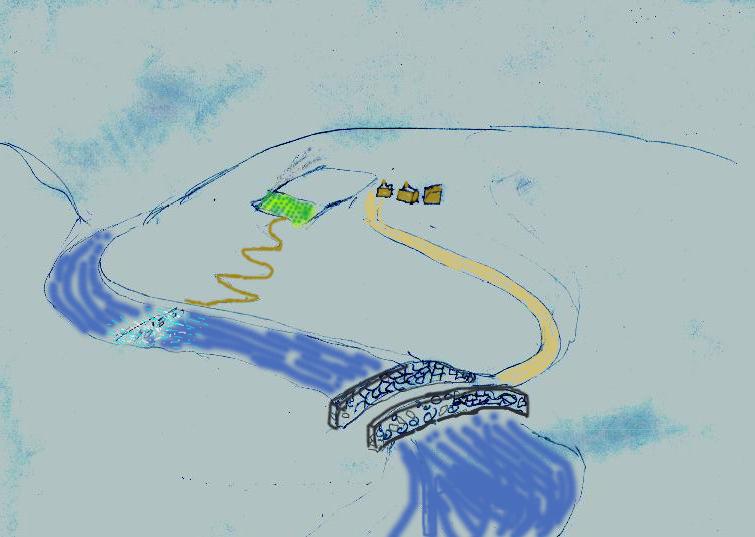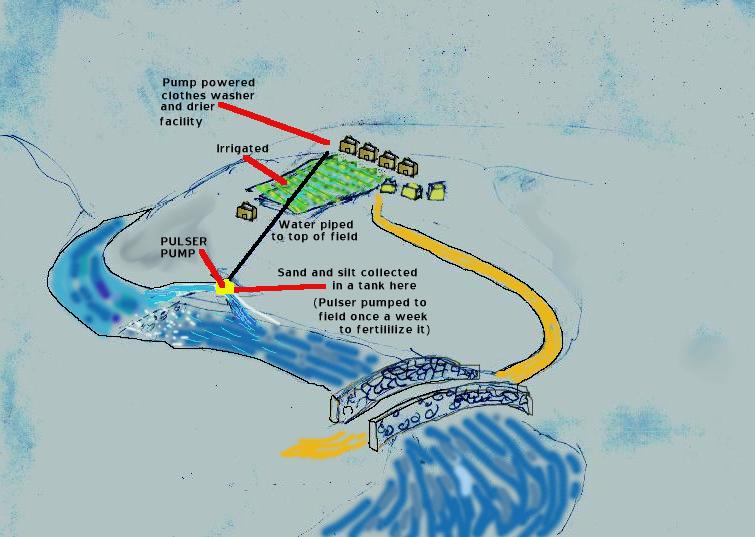I imagine a small very poor riverside village winning a sort of lottery. A poverty relief agency donates 100 meters of 2 inch pipe to the village with the promise that if used correctly, the life of the villagers will be "miles" easier. The villagers live on a small hill 5 meters higher than the river. They must walk the 100 meters to the river (just above the small falls (1 meter high)) and back many times a day to get drinking water and water for their crops. One person carries about 250 liters of water per hour to the crops. It is really tiring work especially on a hot day (and that is when the plants need the water most). Nobody puts in more than 4 hours a day at that work. . They cannot live closer to the river because it occasionally floods.

(They live almost entirely on the produce from their garden plot.) It is an arid region and the river is usually the only source of water. The plan is simple, a deep 'well' is dug near the river. It is 4 meters deep and 2 meters diameter and lined with stone. There is a type of shale available locally that is blocky and ideal for this job. A wooden pipe and a wooden pulser pump chamber are built in the 'well' and connected to the 2 inch pipe. A trench is cut from the wooden pipe to the river just above the falls. This feeds the pulser pump. A trench is cut from the well to the river below the falls. This takes the water away from the pulser pump. Once the village council agreed to the proposal, work on the project went quickly. The promise of relief from watering duty sealed it. Just 2 weeks after work had started, the pump was finished. It was nothing fancy, a single stage pulser pump up an incline. There were other pulser options 50% faster but they went with the simplest one because it was less work.
The river flows at about 200 liters per second at its lowest flow. The pump will use about 30 liters per second of that.

15 liters per minute up at their field is the result! 900 liters per hour all day and night. The people gave 3 people for 2 weeks labour to build the pump
( approximately 250 hours, the relief agency gave the 2 inch pipe). The return was dramatic. Although the pump is not quick, irrigating the fields, it works day and night . It effectively does the work of 10 people in that small village! The payback time for their labour? Just 3 days! The villagers expanded their gardens a little and cautiously awaited problems. The river rose and fell a few times (storms in the mountains). The pulser pump seemed almost unaffected. It stopped for about an hour when water weed clogged the intake sieve but that was it. Finally a big flood came. The agency had advised to them to make a float cut off. They did. The waters rose, the intake water was cut off and the pump went to sleep. As the flood abated a day later the villagers feared the worse. Their 'well' will be filled with silt and will not work! The river falls a little lower and they hear the welcome pechoo! sound again and again. Gushes of brown mud filled water are delivered to the field.
Some silt had got in but nothing like enough to block it up! Now the pump was fertilizing the field too!
Copyright Brian White November 2000
This Story has not happened yet (as far as I know). However the potential is there. I believe that the benefits can be truly great if it does happen.